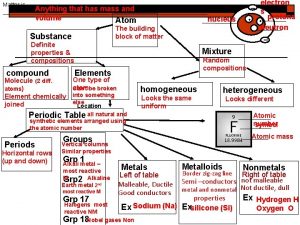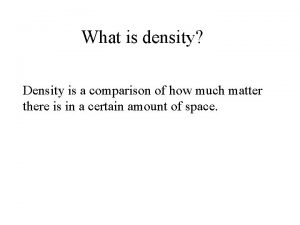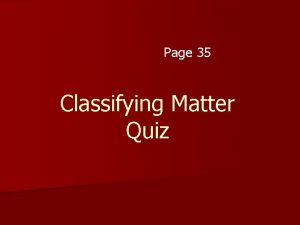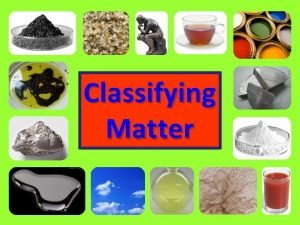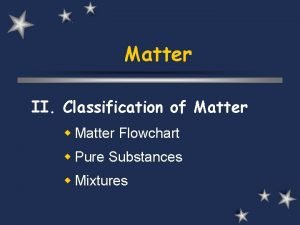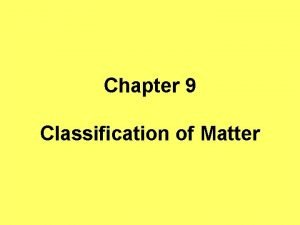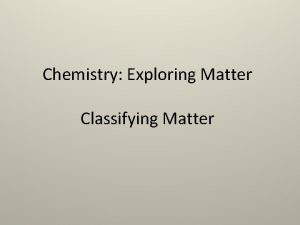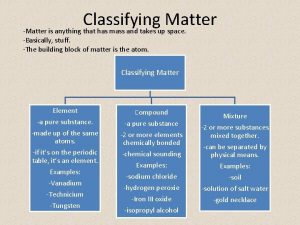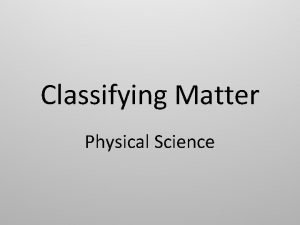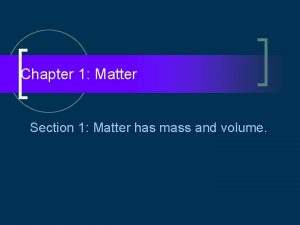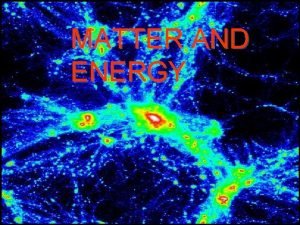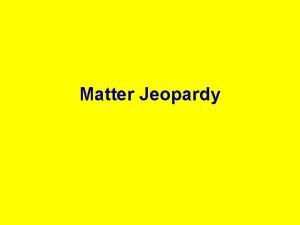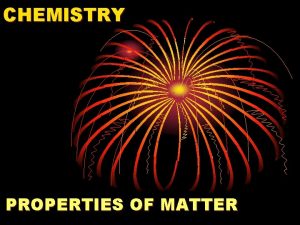Section 2 3 Classifying Matter Matter has mass


















- Slides: 18

Section 2. 3 Classifying Matter • Matter has mass and occupies space. • It is composed of tiny particles called atoms

Section 2. 3 Classifying Matter Objectives 1. To learn to distinguish between mixtures and pure substances 2. To learn two methods of separating mixtures

Section 2. 3 Classifying Matter A. Mixtures and Pure Substances • Matter can be classified as a mixture or a pure substance.

Section 2. 3 Classifying Matter A. Mixtures and Pure Substances Mixtures – A mixture has variable composition. Mixtures are of 2 types: • A homogeneous mixture has the same properties throughout. • A heterogeneous mixture has different properties in different parts of the mixture.

Section 2. 3 Classifying Matter . Mixtures A. A physical blend of two or more components 1. Heterogeneous mixture a. uneven distribution of components b. ex. oil and vinegar 2. Homogeneous mixture a. even distribution of components b. ex. saltwater

Section 2. 3 Classifying Matter A. Mixtures and Pure Substances • A pure substance always has the same composition. • Pure substances are of two types: – Elements which cannot be broken down chemically into simpler substances – Compounds which can be chemically broken down into elements Water is a compound. All the components are the same—H 2 O molecules.

Section 2. 3 Classifying Matter B. Elements and Compounds Elements • Elements contain only one type of atom – elemental copper contains only copper atoms and elemental gold contains only gold atoms.

Section 2. 3 Classifying Matter B. Elements and Compounds • Compounds are substances that contain two or more different types of atoms

Section 2. 3 Classifying Matter B. Separating Mixtures 1. Mechanical Filtration 3. Chromatography 4. Magnetic Separation 2. Distillation

Section 2. 3 Classifying Matter B. Separation of Mixtures can be separated into pure substances by various means. • distillation

Section 2. 3 Classifying Matter B. Separation of Mixtures can be separated into pure substances by various means. • filtration

Section 2. 3 Classifying Matter Extensive Properties of Matter (depend on amount of matter present) 1. Mass a. the amount of matter present in a sample b. measured in grams (g) or kilograms (kg) 2. Volume a. the amount of space taken up by an object b. measured in milliliters (ml) or liters (l)

Section 2. 3 Classifying Matter Intensive Properties of Matter (Depends on the type of matter present) 1. Color 2. Luster - shiny or dull 3. Odor 4. Malleability - may be hammered into different shapes without breaking 5. Ductility - may be drawn into wires 6. Conductivity - may conduct electricity 7. Hardness - ability to scratch other materials 8. Melting / Freezing Point 9. Vaporization / Condensation Point 10. Density

Section 2. 3 Classifying Matter Physical Properties of Matter 1. Can be observed without changing the composition of the substance (extensive and intensive properties) Chemical Properties of Matter 1. Can only be observed by changing the composition of the substance (a chemical reaction must occur)

Section 2. 3 Classifying Matter C. The States of Matter • Matter exists in three states: – Solid: a rigid substance with a definite shape – Liquid: has a definite volume but takes the shape of its container – Gas: takes the shape and volume of its container

Section 2. 3 Classifying Matter Physical Change A. A change in the shape, size or state of matter but not composition B. Reversible Change C. Irreversible Physical Change

Section 2. 3 Classifying Matter . Chemical Change A. Observed when the composition of matter changes 1. Atoms and or molecules are separated, combined or rearranged. 2. Reactants are present before the reaction. 3. Products are present after the reaction.

Section 2. 3 Classifying Matter Properties of Matter Lesson 1. 1. Law of Conservation of Matter In a chemical reaction, the mass of the reactants ALWAYS equals the mass of the products.
 Chapter 2 section 1 classifying matter answers
Chapter 2 section 1 classifying matter answers That which occupies space and has mass
That which occupies space and has mass Matter is anything with mass and volume
Matter is anything with mass and volume A glass sinker has a mass m in air
A glass sinker has a mass m in air Matter is anything that has
Matter is anything that has It is anything that has mass and occupies space
It is anything that has mass and occupies space Anything that occupies space
Anything that occupies space Section 1 composition of matter
Section 1 composition of matter Section 1 composition of matter
Section 1 composition of matter Composition of matter section 1
Composition of matter section 1 Frank has an eraser
Frank has an eraser Classifying matter quiz
Classifying matter quiz Mixture flow chart
Mixture flow chart Classifying matter worksheet
Classifying matter worksheet How is matter classified
How is matter classified What is classification of matter
What is classification of matter Graphic organizer for classification
Graphic organizer for classification Matter flow chart
Matter flow chart Classification of matter quiz
Classification of matter quiz


